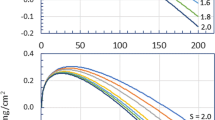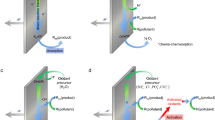Abstract
A mathematical model for internal oxidation kinetics was developed using numerical methods (finite difference) and computer techniques. The flexibility of the model permitted analysis of semi-infinite and finite situations with planar, cylindrical, and spherical geometries for systems with various amounts of local solute enrichment. Graphical results are presented for subscale thickness as a function of time and local enrichment as a function of position in the subscale. The model is also applied to internal oxidation with a discontinuous change in surface oxygen concentration; a graphical solution encompassing a wide range of possible experimental conditions is presented. The use of the model in analyzing nonisothermal internal oxidation problems is demonstrated.
Similar content being viewed by others
References
F. N. Rhines, W. A. Johnson, and W. A. Anderson,Trans. AIME,147, 205 (1942).
L. S. Darken,Trans. AIME,150, 157 (1942).
C. Wagner,Z. Elektroch. 60, 772 (1959).
R. A. Rapp,Corrosion 21, 382 (1965).
J. H. Swisher,Oxidation of Metals and Alloys (American Society for Metals, Cleveland, Ohio, 1971), pp. 235–267.
J. L. Meijering,Advances in Materials Research, H. Herman, ed., (Wiley-Interscience, New York 1971), pp. 1–81.
J. L. Meijering and M. J. Druvesteyn,Philips Res. Repts. 2, 81, 260 (1947).
R. A. Rapp,Acta Metall. 9, 730 (1961).
J. L. Meijering,Z. Elektroch. 63, 824 (1959).
R. A. Tanzilli and R. W. Heckel,Trans. AIME,242, 2313 (1968).
R. D. Lanam and R. W. Heckel,Metall. Trans. 2, 2255 (1971).
R. W. Heckel and M. Balasabramaniam,Metall. Trans. 2, 379 (1971).
A. J. Hickl and R. W. Heckel,Metall. Trans. 6A, 431 (1975).
D. Murray and F. Landis,Trans. ASME, Series D,81, 106 (1959).
W. Eichenauer and G. Müller,Z. Metallkd. 53, 321, 700 (1962).
R. A. Rapp, D. F. Frank, and J. V. Armitage,Acta Metall. 12, 505 (1964).
A. Schoen, Ph.D. Thesis, University of Illinois, 1958.
A. S. Nowick,J. Appl. Phys. 22, 1182 (1951).
C. T. Tomizuka and L. Slifkin,Phys. Rev. 96, 610 (1954).
W. Seith and E. Peretti,Z. Elektroch. 42, 570 (1936).
Author information
Authors and Affiliations
Rights and permissions
About this article
Cite this article
Vedula, K.M., Funkenbusch, A.W. & Heckel, R.W. A mathematical model for internal oxidation. Oxid Met 16, 385–398 (1981). https://doi.org/10.1007/BF00611351
Received:
Issue Date:
DOI: https://doi.org/10.1007/BF00611351




